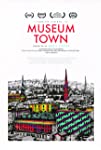Eye For Film >> Movies >> Museum Town (2019) Film Review
Museum Town
Reviewed by: Mateusz Tarwacki

The biggest problem with change is that it's hard to imagine. After all, the transformation of almost 10 hectares of post-factory, ruined space, which is the frozen heart of a city plunged in apathy, into one of the world's largest museums of contemporary art is beyond mind. In her documentary, Museum Town, Jennifer Trainer takes viewers to North Adams, Massachusetts, to prove that such an extraordinary metamorphosis is possible – and that the world of art and culture can be a tool to revitalise deserted towns and to revive economically dead spaces.
North Adams is not unique on the industrial map of the United States, or alongside the many working-class cities and towns in Europe. There are many ghost cities in the world which are becoming devastated and slowly dying out in the absence of any prospects for the future. In colonial times, North Adams was founded and economically based on small production plants. The Civil War brought a moment of prosperity for the city – a printing cloth factory, Arnold Print Works, was established, which produced uniforms for Union soldiers. It was closed during the Great Depression and replaced by the Sprague Electric Company, which was producing capacitors. The factory was closed in 1985 due to the outdated technology of capacitors.
Since the mid-1980s, the city has been suffering from a crisis – due to the closure of the plant, thousands of employees lost their jobs, and North Adams slowly began to turn into a ghost town. Rescue for the residents came from a completely unexpected side - a group of artists from the nearby Williams College Museum of Art were looking for a sufficiently spacious museum space that would accommodate large-scale exhibits. More than a decade passed from that moment to the opening of The Massachusetts Museum of Contemporary Art in 1999.
Although Trainer is interested in reporting the history of the city and the idea of ??the museum-factory, she does not focus only on the story of the old days. The director shows both the possibilities of transforming a factory into a cultural object, as well as the multitude of obstacles and work that have been put into this idea. Each museum is a place of constant creative effort to attract both viewers and artists (for example, David Byrne appears on the screen) who want to cooperate with the institution. The work of the mayor in the film becomes confusingly similar to the work of a museum curator – the city is also a space of constant creative work, especially in the face of crises, otherwise it falls into apathy.
The title of the film becomes emblematic here. It is not only – literally – a town that has become a museum, but also a town that learns, using museum experience and tools, to rebuild itself by using crisis conditions to its advantage. Museum Town is not only a story about how art can revive the urban tissue and the local economy. It is also a story about a life after an economic apocalypse – which is something particularly comforting not only in the matter of ghost towns, but also of the situation of the world’s cultural sectors, particularly when they're hit by a global pandemic.
Reviewed on: 16 Dec 2020
















